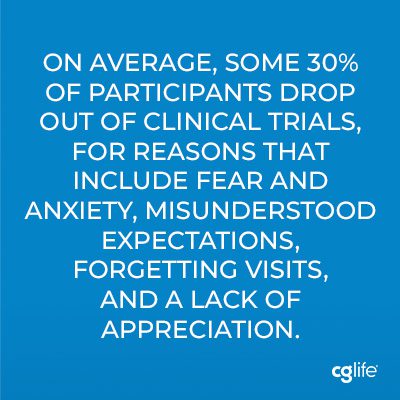There’s a business case to be made for naming and branding a lot of clinical trials – particularly those in the later stages of development. But below, we dive into one aspect of the discussion: how changes to the way clinical trials are being run are increasing the pressure – and the incentives around – naming and branding yours. Specifically, there are three interwoven themes that are changing the landscape in a positive way, while producing some undeniable challenges.
Adopting a Patient-Centric Focus
Echoing a shift that’s playing out in medicine as a whole, clinical trials are now moving towards a more ‘patient-centric’ approach. To maximize both enrollment and retention, the onus is increasingly on the study sponsor to adapt to the patient’s lifestyle, needs, and location. Put simply: the study should serve the patient, not the other way around.
In real terms, this means you need to contextualize and translate your trial into terms the patient can understand. NB33r is your drug, the UNICORN Study is what you’re offering them. It speaks to who they are – not your business aims.
Clearly, for investigational therapies, we can’t advertise the potential benefits. But that’s where a great logo, name, color palette can indirectly create a connection with participants. This is particularly true for diseases such as type II diabetes, that face competition from a multitude of branded FDA-approved therapies. As noted in the title above, it’s easier to pitch a study than a license plate.
Personalized Medicine Calls for Personalized Trials
While many studies now feature a patient-centric design, the therapies themselves have also become more personalized. As a result, trial sponsors often don’t have the luxury of a wide population to recruit from; they’re looking to engage specific patients with a certain mutation or at a particular stage of disease progression. Perhaps they’re targeting a rare or orphan disease – 50% of which affect pediatric populations.
A reactive approach to recruitment (unsurprisingly) falls short in these challenging scenarios. Biopharma companies need a much more compelling pitch, as the pool of potential participants is small and scattered geographically. They also need to win over not just to the patient, but the entire care team. That might include doctors, parents, siblings, and other caregivers.
One way to overcome some of these barriers is by tapping into patient networks, whether that’s through online communities, such as PatientsLikeMe, or through patient registries such as the National Organization for Rare Diseases (NORD) in the U.S., or its European equivalent EURORDIS. Either way, it’s better to begin your outreach with an appropriately-named and branded trial and one that inspires confidence. Off-the-shelf therapies don’t work for this audience; off-the-shelf marketing and messaging won’t either.
Surviving In a Virtual World
Alongside these two shifts, is the move towards virtual or “de-centralized” studies. For years, clinical trials have clustered around major hospitals in urban centers. If you’re close to Johns Hopkins, that’s great. However, for rural Americans – particularly minorities – the location of trial sites has been an ongoing source of inequality. Many simply haven’t had access to the latest investigational therapies.

For biopharma companies, relying on a subset of elite U.S. hospitals also has its drawbacks. It can limit study enrollment significantly, dragging out timelines and costs. It’s a particularly bad move when operating in a crowded space, such as non-alcoholic steatohepatitis (NASH) or Alzheimer’s disease.
The solution is to be more proactive and take the trial to the participants. Some companies achieve this by setting up individual trial sites at medical centers close to the patient. Other organizations, such as Science 37, have a truly virtual approach, setting up the infrastructure around the individual so they can participate from home. Either way, the branding has to cut through a lot of noise, and you can’t rely on physician referrals. Virtual trials need a memorable name and brand that truly stands on its own.
Strategic marketing can also be used as a tool for fostering patient retention. On average, some 30% of participants drop out of clinical trials, for reasons that include fear and anxiety, misunderstood expectations, forgetting visits, and a lack of appreciation. Trial sponsors have to work extra hard to overcome these barriers remotely. They regularly need to remind participants that their involvement in the study is important and that they have the support and care of a wider team. This is hard to achieve when your trial is just a number. Conversely, appropriate naming and branding communicate that you’re investing in this study. Done well, it can increase the sense of community and, ultimately, accountability and retention.
Clinical Trials and Branding: Final Thoughts
There are some things that have remained constant in this field. One of those, in relation to the naming and branding of your clinical trial, is the real need to plan and prepare ahead. If your study enrollment is lagging, it’s probably already too late to launch a marketing initiative that can move the needle.
Our other nugget of humble advice is that a name and a logo are nothing without a strategic marketing engine behind them. For successful patient engagement, recruitment, and retention, we also need to be thinking about how to include key opinion leaders, what online and offline materials should be available, and overall disease awareness. All of this brings visibility to your name and logo and puts it into context.
CG Life has been doing life science brand strategy, creative development, and logo design since 2003. We back this with a fully-integrated marketing team, which includes content and digital marketing, paid media, and PR. So if you’re in the planning stages of a trial or just want to chat more, give us call (or an email, or fill out a form). We’ve seen trends come and go. We know the pitfalls to avoid and understand the journey your drug program will take through review boards, legal and compliance teams, and even doctors’ offices.
